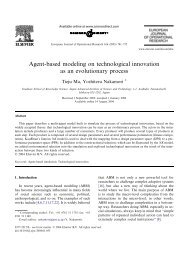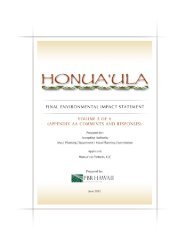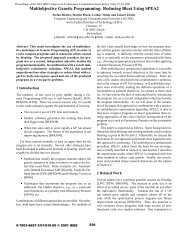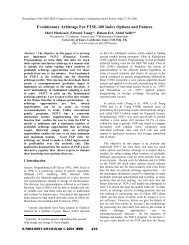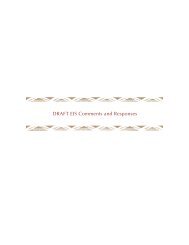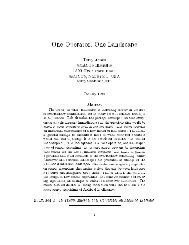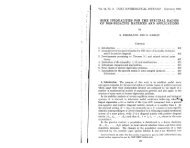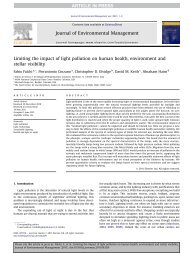4 description of the human environment, potential ... - Lee Altenberg
4 description of the human environment, potential ... - Lee Altenberg
4 description of the human environment, potential ... - Lee Altenberg
Create successful ePaper yourself
Turn your PDF publications into a flip-book with our unique Google optimized e-Paper software.
Final Environmental Impact Statement<br />
During <strong>the</strong> time <strong>of</strong> Kamehameha <strong>the</strong> Great, large quantities <strong>of</strong> sandalwood were harvested<br />
from mauka areas (Kula, Makawao, and Haleakalä) and loaded at Mäkena.<br />
Kamehameha <br />
king Kalanikupule (Sterling 1998). Afterwards, <strong>the</strong> fishponds <strong>of</strong> Kalepolepo and Kö<br />
were rebuilt. <br />
sweet potato, sugar cane, and ranching were key activities <strong>of</strong> <strong>the</strong> region. The <br />
(common people) worked <strong>the</strong> land under <strong>the</strong> direction <strong>of</strong> <strong>the</strong> konohiki and occasionally<br />
<strong>the</strong> would drop by enroute to Kaupö, where most <strong>of</strong> <strong>the</strong> activities <strong>of</strong> <strong>the</strong> chiefs took<br />
place.<br />
In post-contact times, Mäkena Landing became <strong>the</strong> second busiest port after Lahaina since<br />
cattle and agricultural products from <strong>the</strong> mauka lands were brought here to load, and <strong>the</strong><br />
port received goods for residents throughout Central Maui. <br />
settlement patterns underwent major changes throughout <strong>the</strong> region and <strong>the</strong> entire island<br />
with: 1) <strong>the</strong> advent <strong>of</strong> cattle and commercial agricultural enterprises; 2) <strong>the</strong> introduction <strong>of</strong><br />
<strong>the</strong> western concept <strong>of</strong> private ownership <strong>of</strong> land; and 3) <strong>the</strong> development <strong>of</strong> cart paths,<br />
roadways, and harbors.<br />
Following <strong>the</strong> overthrow <strong>of</strong> <strong>the</strong> Hawaiian monarchy, Handy (1940) reported <strong>the</strong> following<br />
changes in <strong>the</strong> area due to cattle ranching:<br />
In Honuaula, as in Kaupo and Kahikinui, <strong>the</strong> forest zone was much lower and<br />
rain more abundant before <strong>the</strong> introduction <strong>of</strong> cattle. The usual forest-zone<br />
plants were cultivated in <strong>the</strong> lower upland above <strong>the</strong> inhabited area. Despite<br />
two recent (geologically speaking) lava flows which erupted from fissures<br />
below <strong>the</strong> crater and only a few miles inland and which covered many square<br />
miles <strong>of</strong> land, <strong>the</strong> eastern and coastal portion <strong>of</strong> Honuaula was thickly<br />
populated by Hawaiian planters until recent years. A few houses are still<br />
standing at Kanaio where <strong>the</strong> upper road (travelling eastward) ends but only<br />
two are now occupied. A number <strong>of</strong> Hawaiian families whose men are<br />
employed at Ulupalakua Ranch have homes near <strong>the</strong> ranch house. Above<br />
<strong>the</strong>se native homes a little dry taro is cultivated. Formerly, <strong>the</strong>re was much dry<br />
taro in <strong>the</strong> forest zone.<br />
Cattle and<br />
goats stripped <strong>the</strong> land <strong>of</strong> its native flora while destroying ancient Hawaiian temples and<br />
o<strong>the</strong>r traditional Hawaiian remains<br />
4.2.2 Ahupuaa within <strong>the</strong> Honuaula Property<br />
The Honuaÿula Property includes portions <strong>of</strong> three ahupuaa: Paeahu, Palauea, and<br />
Keauhou from north to south. Most <strong>of</strong> <strong>the</strong> nor<strong>the</strong>rn two-thirds <strong>of</strong> <strong>the</strong> Property is within a<br />
section <strong>of</strong> Paeahu ahupuaÿa. Roughly half <strong>of</strong> <strong>the</strong> width <strong>of</strong> Palauea ahupuaÿa is within <strong>the</strong><br />
Honuaÿula Property, with <strong>the</strong> remainder extending north. The entire width <strong>of</strong> Palauea<br />
ahupuaÿa is within <strong>the</strong> Honuaÿula Property, primarily within <strong>the</strong> sou<strong>the</strong>rn third <strong>of</strong> <strong>the</strong><br />
CHAPTER 4 DESCRIPTION OF THE HUMAN ENVIRONMENT, POTENTIAL IMPACTS, AND MITIGATION MEASURES<br />
110



